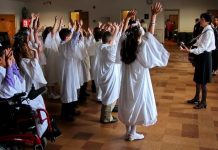
ELIZABETH ANNE STEWART
Built in 1880, right after the Chicago Fire, Old St. James has a rich history that includes being the first racially integrated church in Chicago. When my family joined the parish in the early 1980s, the church had recently survived a fire of its own. Beating all odds, the community arose from the ashes, the church building intact, and continued its mission of social outreach and liturgical excellence.
The Thanksgiving service at St. James is what drew us to the parish in the first place. There, the community would gather for Mass on Thanksgiving morning, eager for that moment when the pastor would invite those present to step forward to the microphone. Here, in this inner city parish that served several colleges, housing projects, and nursing homes, men and women would rise to tell their stories of finding new faith, getting a job after months of unemployment, overcoming a drinking problem, surviving a major surgery, “being saved” from life in a gang, breaking free from an abusive relationship, or seeing a loved one released from jail.
Sometimes the elderly and infirm had to be assisted to the microphone; sometimes children were so nervous that their words were lost in delivery. It was this “human” element that made each Thanksgiving liturgy so moving: However great their difficulties, the people still praised God for the gift of life.
Although it was a custom at St. James to socialize after every Mass, the emotional intensity after Thanksgiving liturgy made this even more important. We gathered at the back of the church to share cake, coffee, and fellowship. Then, instead of going home to feast, we would walk over to the school hall, where we busied ourselves with packing dinners that other parishioners would deliver to shut-ins. My children, Peter and Alexia, piled cranberry relish, stuffing, salad, yams, turkey, and pumpkin pie into Styrofoam compartments until the lids barely fit in place; they took great satisfaction in making sure that everyone got plenty of everything.
That task accomplished, we would assist other volunteers with setting tables, finishing the job just in time to greet two busloads of seniors. They came in their best clothes, looking forward to a “proper meal” for a change. For many, this event was one of the highlights of the year, an opportunity to socialize with their peers in a multi-generational setting. More than the food, they loved the presence of children, and the children—mine included—lapped up the attention!
Celebrating Thanksgiving at St. James challenged us to be profoundly grateful for self and creation, to move beyond being thankful to having an active concern for the poor. The poor taught us the true meaning of gratitude. When those who seemingly have nothing can pray as though God has given them everything, that is faith. When those whose sufferings have no end in sight can still sing, “We shall overcome,” there is hope! When those who have been oppressed welcome the privileged into their midst, allowing them to “feel good” about volunteering, that is love.
This beautiful historic church was recently demolished. Even in our mourning, there is still room for gratitude: The people of St. James have reconnected as old friends and shared precious memories—all for which I am deeply grateful, especially at Thanksgiving.
Elizabeth-Anne Stewart, PhD, is a Chicago-based author. Visit her website at elizabeth-annestewart.com.
This article was originally published in RTJ’s creative catechist November/December 2013.
Image: PeoplesImages, istock




